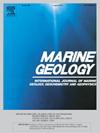Particulate organic carbon dynamics off the Yellow River Estuary revealed by in-situ hydrodynamics and carbon isotopes
IF 2.2
3区 地球科学
Q2 GEOSCIENCES, MULTIDISCIPLINARY
引用次数: 0
Abstract
The Land-to-Ocean-Aquatic-Continuum (LOAC) is a key component in global carbon cycle and budget. Delivery of organic carbon (OC) along the LOAC is impacted by coastal hydrodynamics on a variety of spatial-temporal scales. Here we provide a coupled analysis of suspended particulate OC (POC) transport and hydrodynamics in the Yellow River Estuary. Pre-aged soil POC has become the dominant component (40–50 %) in the river-estuary continuum during the flood season. Petrogenic POC, with high proportion in the river (31 %), experienced drastic deposition off the estuary due to entrapment by shear fronts and estuarine circulation, decreasing to 19–23 %. The terrestrial OC was mainly exported offshore along with the seaward extension of river plume during ebb tide, while could be pushed landward by intruding seawaters during flood tide. When the tidal effects were removed, the first-order net POC residual flux was ∼19 g/m/s in seaward direction in the near-field plume, with dominance of pre-aged soil POC at ∼8 g/m/s and petrogenic POC at ∼6 g/m/s; on the contrary, POC fluxes displayed a landward direction and decreased by two orders of magnitude in the far-field plume. Trapped by shear fronts and estuarine circulation, POC was mostly limited and temporally preserved off the river mouth during the flood season. These findings suggest that intra-tidal estuarine hydrodynamics can further influence the sources, composition, and transport of terrestrial POC, playing a significant role in regulating carbon cycling along the Land-to-Ocean-Aquatic-Continuum.
原位水动力学和碳同位素揭示的黄河口颗粒有机碳动态
陆-海-水连续体(LOAC)是全球碳循环和碳收支的重要组成部分。有机碳在不同时空尺度上受海岸水动力的影响。本文对黄河口地区悬浮颗粒物OC (POC)输运与水动力学进行了耦合分析。在汛期,预老化土壤POC已成为河口连续体的主导成分(40 - 50%)。成岩POC在河中所占比例较高(31%),受剪切锋和河口环流的夹闭作用,在河口外沉积剧烈,减少至19 - 23%。退潮时,陆源OC主要随河羽向海延伸向外输出,涨潮时,陆源OC可被入侵海水推向陆地。去除潮汐效应后,近场羽流向海方向的一阶净POC残余通量为~ 19 g/m/s,以预熟土壤POC为~ 8 g/m/s,成岩POC为~ 6 g/m/s为主;而在远场羽流中,POC通量呈现向陆地方向,减小了2个数量级。由于受切变锋和河口环流的限制,POC在汛期主要局限在河口附近,并被暂时保留。这些结果表明,潮内河口水动力可以进一步影响陆地POC的来源、组成和运输,在调节陆地-海洋-水-连续体的碳循环中发挥重要作用。
本文章由计算机程序翻译,如有差异,请以英文原文为准。
求助全文
约1分钟内获得全文
求助全文
来源期刊

Marine Geology
地学-地球科学综合
CiteScore
6.10
自引率
6.90%
发文量
175
审稿时长
21.9 weeks
期刊介绍:
Marine Geology is the premier international journal on marine geological processes in the broadest sense. We seek papers that are comprehensive, interdisciplinary and synthetic that will be lasting contributions to the field. Although most papers are based on regional studies, they must demonstrate new findings of international significance. We accept papers on subjects as diverse as seafloor hydrothermal systems, beach dynamics, early diagenesis, microbiological studies in sediments, palaeoclimate studies and geophysical studies of the seabed. We encourage papers that address emerging new fields, for example the influence of anthropogenic processes on coastal/marine geology and coastal/marine geoarchaeology. We insist that the papers are concerned with the marine realm and that they deal with geology: with rocks, sediments, and physical and chemical processes affecting them. Papers should address scientific hypotheses: highly descriptive data compilations or papers that deal only with marine management and risk assessment should be submitted to other journals. Papers on laboratory or modelling studies must demonstrate direct relevance to marine processes or deposits. The primary criteria for acceptance of papers is that the science is of high quality, novel, significant, and of broad international interest.
 求助内容:
求助内容: 应助结果提醒方式:
应助结果提醒方式:


